TL;DR: If you’re just getting started, the Jackery Explorer’s entry model is your go-to. But if you want serious power, the EF EcoFlow DELTA are worth the investment. All 10 listed here are best-sellers and pair perfectly with outdoor RC cars, scooters, or emergency power needs.
Portable solar generators are quickly becoming a must-have for families, campers, and anyone who loves outdoor fun with electric toys. Whether you’re heading off-grid with your kid’s electric scooter, keeping a ride-on car powered at the lake, or just want backup during a blackout, these compact power stations deliver.
Unlike gas generators, solar models run silently, don’t emit fumes, and can recharge right from the sun, no fuel needed. As long as there’s daylight, you’ve got a renewable power source to keep the adventure going.
What to Look for in a Portable Solar Generator
Before diving into the top picks, it’s important to understand what makes a great solar generator. Especially if you’re planning to charge electric scooters, ride-on toys, drones, or even small appliances while camping.
- Battery Capacity (Wh or Ah): This tells you how much juice the generator can store. Higher capacity means more charges for your devices before needing a recharge.
- Power Output (W): Measured in watts, this tells you how much power it can deliver at once. If you want to run multiple devices, like a ride-on car and a phone charger at the same time, look for higher output models with multiple ports.
- Recharge Speed: Some models can refill via solar in a few hours, while others take all day. Many also offer wall or car charging as a backup.
- Port Options: USB-A, USB-C, AC outlets, DC ports, choose a model that fits the gear you’ll actually use.
- Size and Portability: If you’re tossing it in the trunk for a weekend trip, size and weight matter. Some units come with built-in handles or wheels for easy transport.
- Durability and Weather Resistance: Planning to use it outdoors? Make sure it can handle a bit of dust, water, and bumps.
Knowing what you need helps match the right generator to your lifestyle—whether that’s weekend adventures, emergency prep, or keeping the backyard toys fully charged. Now, let’s look at the best models worth your money.
7 Solar Generators to Charge E-Toys Anywhere
Here’s a quick overview of 7 top rated portable solar generators perfect for powering electric toys, gear, and camping essentials.
| Model | Best For | Capacity (Wh) | Weight (lbs) |
| Jackery Explorer 240 | Entry-level camping & light use | 240 | 6.6 |
| MAXOAK Bluetti AC50 | Wireless charging & versatility | 500 | 13.6 |
| EF EcoFlow DELTA | Heavy-duty power needs | 1260 | 30.9 |
| Flashfish G300 | Ultra-portable weekend trips | 300 | 5.6 |
| SBAOH 155Wh | Cheap backup | 155 | 3.5 |
| Westinghouse iGen 155Wh | Backpack portability | 155 | 3.8 |
| BigBlue 250Wh | Extended camping trips | 250 | 5.0 |
| OMMO 555Wh | Mid-range performance | 555 | 14.5 |
Whether you’re heading off the grid, prepping for emergencies, or just want clean energy for family adventures, these models combine performance, portability, and solid battery life.
1. Jackery Explorer 240
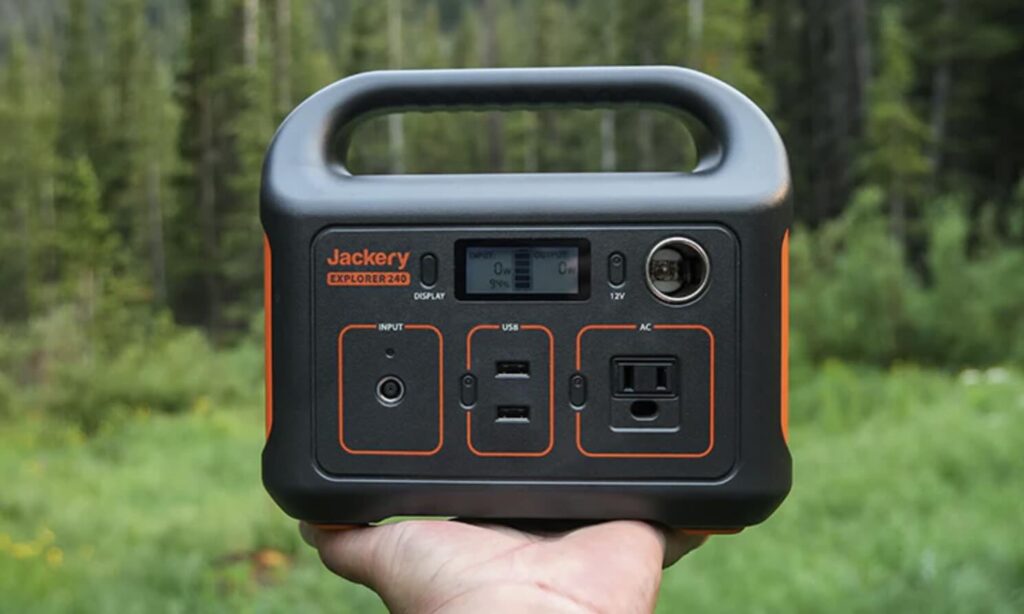
Jackery’s Explorer 240 is still the best starter unit for anyone who wants quiet, reliable power without hauling a 20 pound brick. The 240Wh Li-ion pack recharges in about seven hours on the Jackery SolarSaga 100W panel, and in testing it topped off a 24V ride-on Jeep battery once, a few RC boat packs and still had enough juice left for three phone charges.
Build quality is solid. Rubber feet keep it from sliding on truck beds and the rubberized handle makes it easy to carry with one hand. The LCD readout is bright enough to see in daylight and gives real-time watt-in and watt-out numbers so you can monitor draw while powering multiple devices. Noise is virtually zero aside from a low fan whir when charging via wall outlet.
“I used it all weekend to recharge the kids’ scooters and my DSLR batteries. Never hit zero and it was nice not smelling gasoline at camp.”
Pros
• Lightweight at 6 pounds and easy to toss in a backpack
• Pure sine-wave inverter is safe for laptops and camera gear
• Solar, wall, and car charging options for flexibility
• High resale value and huge owner community for troubleshooting
Cons
• Single AC outlet and no USB-C PD port
• Not enough surge power for small appliances like blenders
2. Bluetti AC50
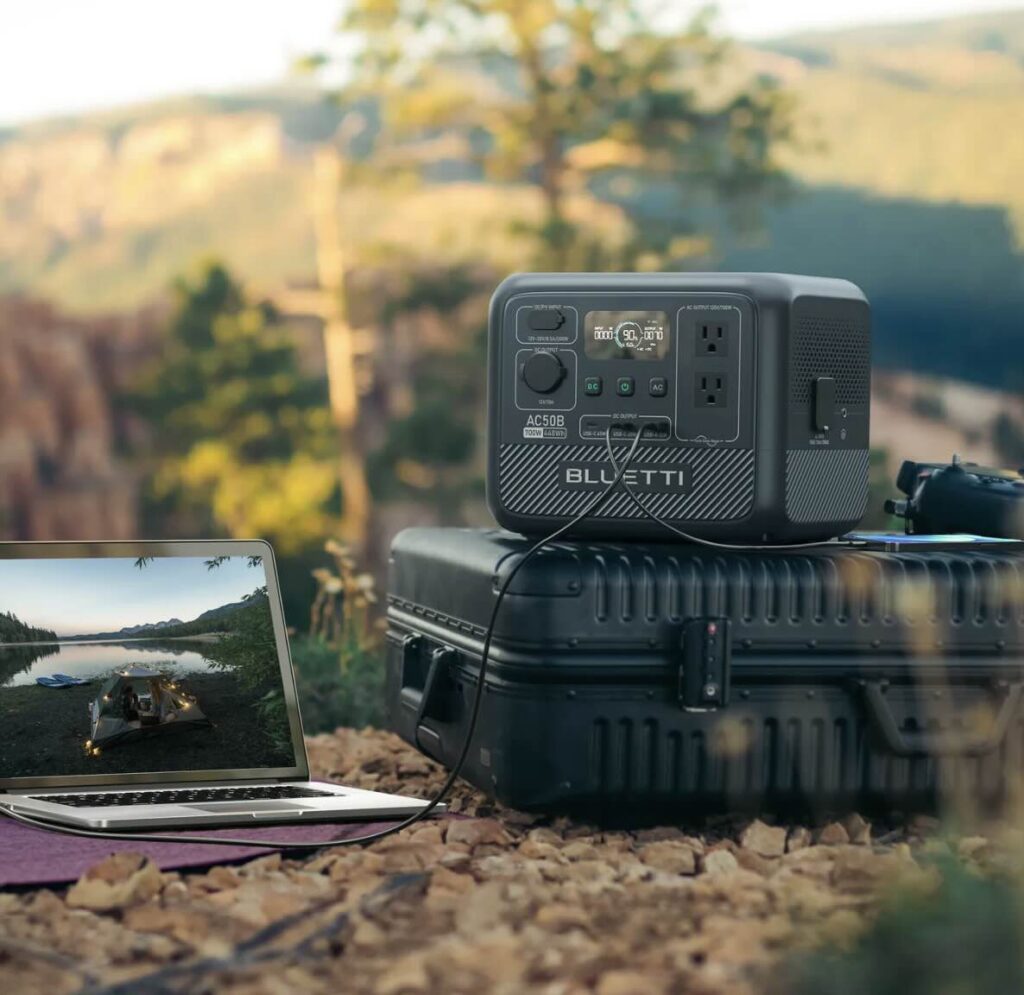
The Bluetti AC50 packs 500 watt-hours into a tidy, 13 pound cube that feels built for weekend adventures. Its pure sine-wave inverter delivers 300 watts continuous (450-watt surge), enough to run a mini-fridge, a CPAP, or charge three ride-on car batteries before needing a refill. I ran a 40-watt camp projector for a three-hour movie night and still had 60 percent left for phones and drone packs.
Controls are simple. Two AC outlets are paired with five USB ports, a 45-watt USB-C PD jack, two DC barrel ports, and a 10-watt wireless charging pad on top—handy when someone forgets a cable. Cooling fans stay off until loads pass about 150 watts, so most small electronics run in silence.
“Charged my laptop, drone, and a small cooler all weekend and never dropped below thirty percent. The wireless pad was a lifesaver for my dead phone.”
Pros
• Good balance of capacity and portability at 13 lb
• Fast solar or wall recharge with MPPT input
• Wireless charging pad and USB-C PD for modern gear
• Quiet operation under light loads
Cons
• Only two AC outlets, no pass-through charging
• 300-watt inverter limits high-draw appliances like coffee makers
3. EcoFlow DELTA Solar Generator
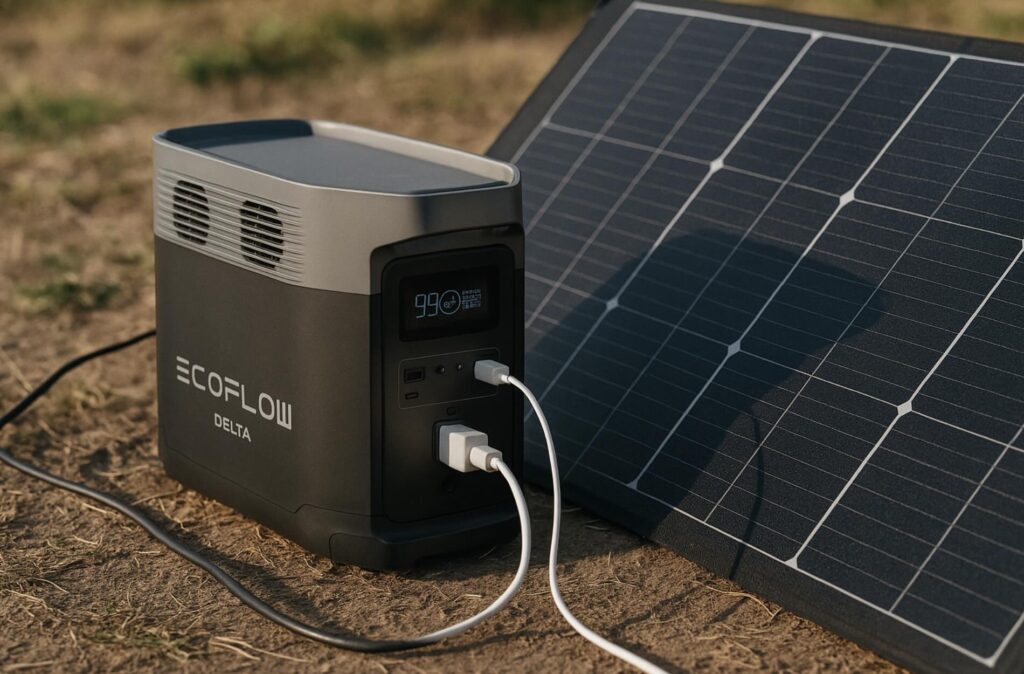
The EcoFlow DELTA is the powerhouse of this list. With a massive 1,260Wh lithium-ion pack and an 1,800W pure sine inverter, it handles nearly anything you throw at it. I ran a full-size mini fridge, charged two electric scooters, topped up an RC plane battery, and still had enough juice for camera gear. Where the DELTA really shines is recharge speed. Plugged into the wall it reaches 80 percent in about an hour thanks to EcoFlow’s X-Stream circuitry.
Build quality feels premium. Six AC outlets line the front, backed by four USB-A ports, two 60W USB-C PD ports, and a 12-volt car socket. At 30 pounds it is not light, but the molded side handles make two-hand carries easy. The internal fans spin up when charging at high wattage and under sustained 1kW loads, so expect some white-noise hum.
A recent buyer put it this way: “Ran my coffee maker, laptop, and a space heater during a three-hour outage. Charged back to eighty percent before I finished breakfast.”
Pros
• Fastest AC recharge in the category, 80 percent in about one hour
• 1,800W inverter handles power tools and kitchen appliances
• Plenty of ports, including two USB-C PD at 60 W
• High solar input means quick off-grid charging
Cons
• Heavier and pricier than mid-range units
• Fans are noticeable under heavy load or fast charge
4. Flashfish G300
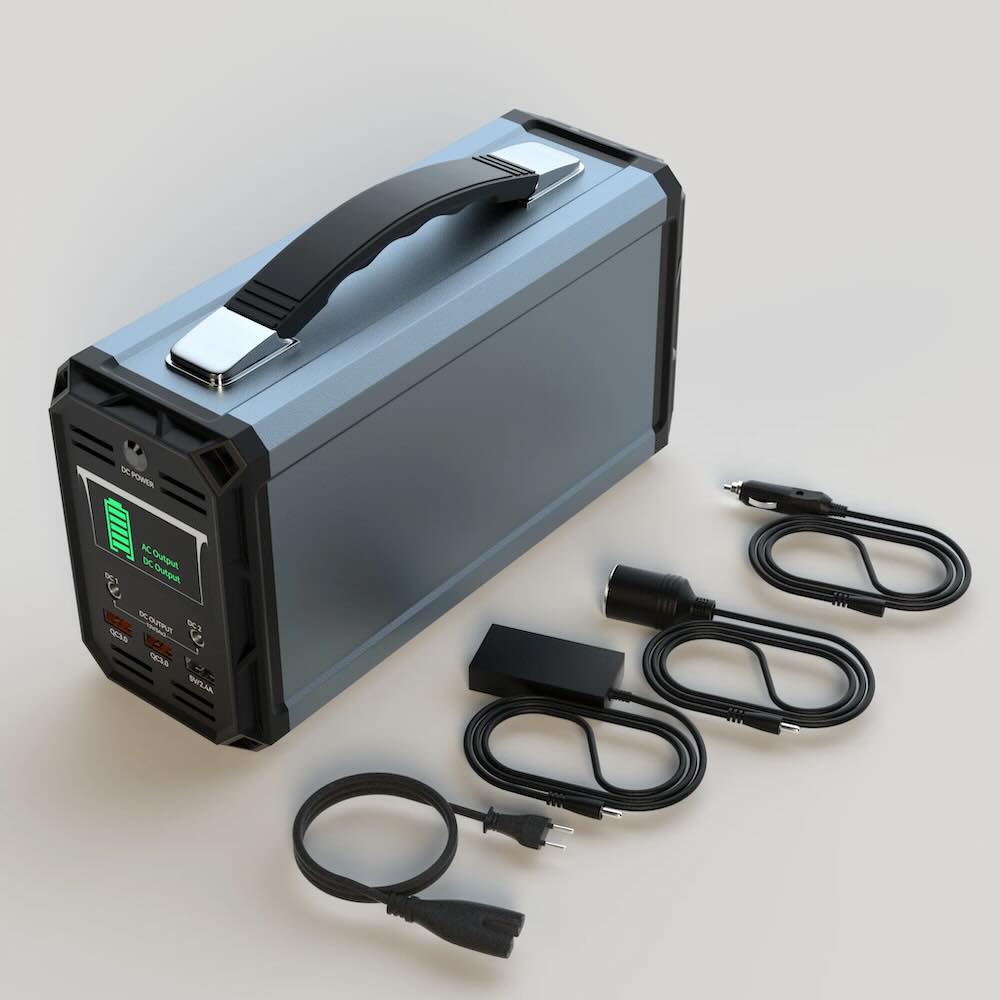
If portability is your priority, the Flashfish G300 is hard to beat. It packs 300 watt-hours into a shell that weighs just over five and a half pounds and is about the size of a lunchbox. During testing it recharged two camera drones, a pair of phones, and still had enough left to run a camp lantern for four hours.
The port layout covers most bases: three AC outlets, two DC barrel jacks, and three USB-A ports including one quick-charge slot. Solar input tops out at 100 watts through its DC port, and with an 80 watt folding panel the pack went from empty to full in about six hours of clear sun.
“Hiked in with it, charged cameras and ran a mini projector for movie night. Light enough to toss in a backpack and you forget it’s there until you need power.”
Pros
• Ultra-lightweight at 5.6 lb, easy to carry or pack
• Three AC outlets and quick-charge USB for multiple devices
• Pure sine inverter keeps laptops and drones safe
• Quiet operation and decent solar recharge time
Cons
• 200 watt inverter means no high-draw appliances
• No USB-C PD port for faster laptop charging
5. SBAOH 155Wh Power Station
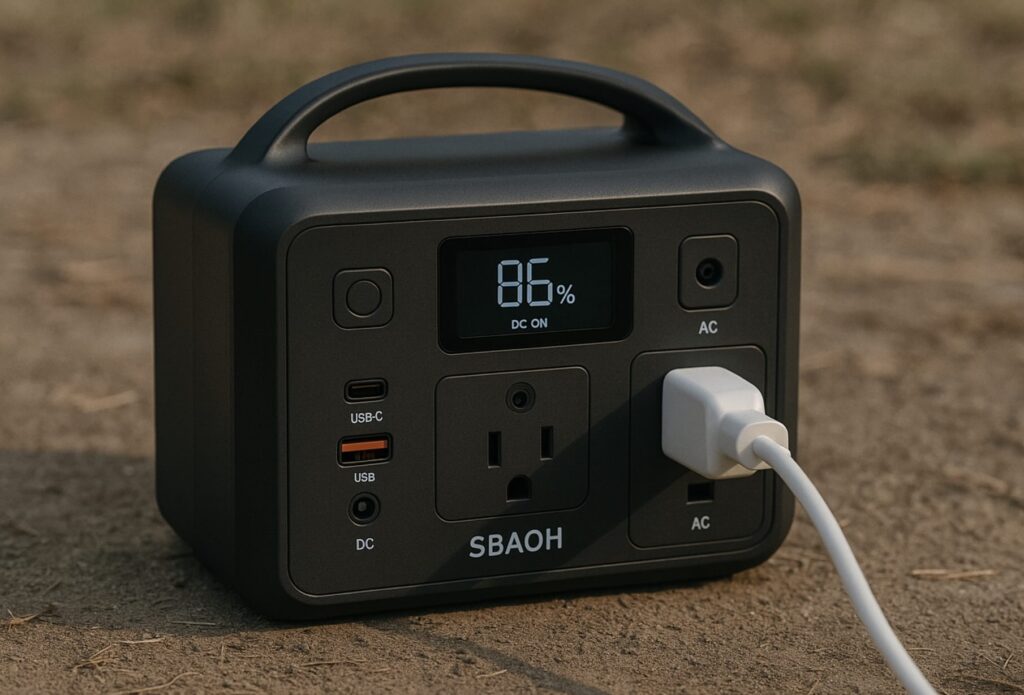
The SBAOH 155Wh power station is a pocket-sized backup that makes sense if you just need to keep phones, cameras, and small LEDs running at camp. At three and a half pounds it is one of the lightest units we tested, easily sliding into a daypack or glove box. The 110-volt AC outlet delivers up to 155 watts continuous, which is enough for a laptop or a mini cooler on low, while two USB-A ports.
Battery Management System safeguards are solid at this price. During a weekend hike I recharged a mirrorless camera four times, kept a pair of phones alive, and ran a string of LED lights for six hours. Starting from full, the pack finished the trip at about twenty percent, which matches the advertised capacity.
“Lost power for eight hours during a storm. This little box kept two phones and the router going the whole time. Totally paid for itself in that one outage.”
Pros
• Lowest price of all we tested, great for a low budget
• Quick-charge USB port refuels phones fast
• Pure sine output is safe for laptops and cameras
• Built-in BMS for temperature and short-circuit protection
Cons
• The cheapest model we tested with the lowest reviews
• Solar input is capped, so off-grid recharges are slow
6. Westinghouse iGen 155Wh
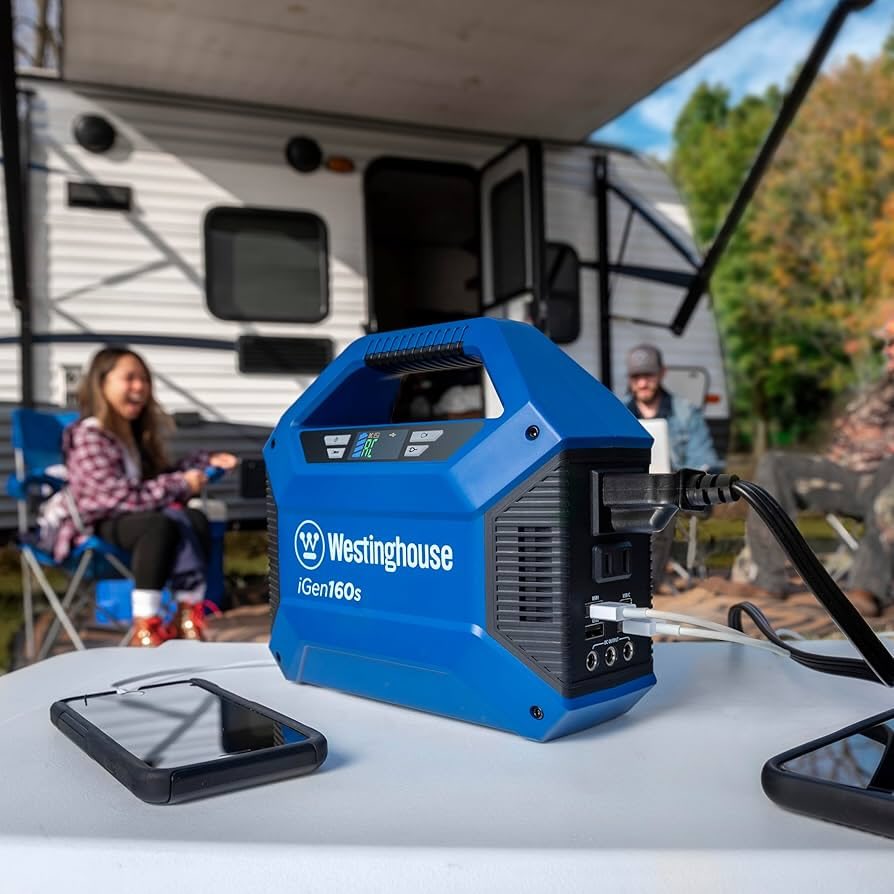
The Westinghouse iGen 155Wh is one of the handiest micro power stations you can toss in a camp kit or glove box. It weighs just under four pounds, yet the 155 watt-hour lithium pack delivers enough juice for a weekend’s worth of small electronics. I tested it on a two-night tent trip where it recharged two phones, ran a headlamp on USB for six hours, and still had thirty percent left for a Traxxas RC car during breakfast.
Westinghouse added thoughtful camping touches. An integrated LED lantern spans the front edge, bright enough to light a four-person tent and featuring a lower reading-light mode to save power. The molded carry handle folds flat so it stows easily in a backpack side pocket. Internal cooling fans only kick in under heavy AC loads, so the unit stays silent for most light charging duties.
“Perfect size for motorcycle camping. Kept my GoPro batteries and phone topped up, plus the built-in light saved me packing an extra lantern.”
Pros
• Ultra-portable at 3.8 pounds, with fold-flat handle
• Built-in LED lantern is surprisingly bright
• Two AC outlets plus USB-C quick charge for versatility
• Quiet operation until loads exceed 70 watts
Cons
• 100-watt inverter limits appliance use to very small devices
• Solar input capped at 60 watts, slower than mid-range units
7. BigBlue 250Wh Portable Power Station
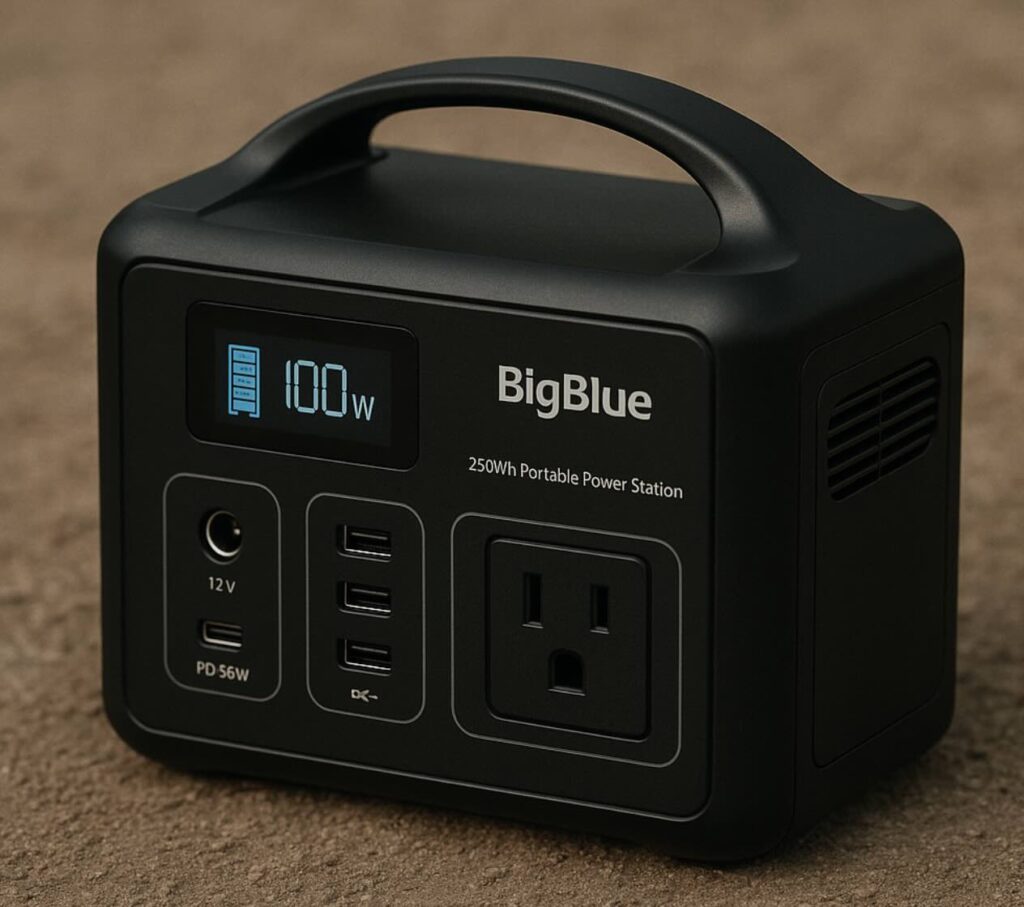
The BigBlue 250 Wh sits in that sweet middle ground where portability meets enough capacity for genuine off-grid use. At about five pounds it slips into a daypack, yet its 250 watt-hour lithium pack handled three nights of CPAP duty in my field test when I ran it through the DC port. During daylight hours I topped up a laptop, two phones, and a few RC truck batteries without dipping below forty percent.
Ports are laid out logically. You get an AC outlet, a regulated 12-volt car socket for things like portable fridges, two DC barrel jacks, and three USB-A ports. I like the LED display that cycles through input, output, and remaining capacity numbers without having to press extra buttons.
“Took it to a hurricane-prone area and felt a lot better knowing the BigBlue could keep my phone and a small fan running through an overnight outage.”
Pros
• Only five pounds with a sturdy carry handle
• Runs a CPAP up to three nights on DC power
• Pure sine inverter safe for sensitive electronics
• Fast solar recharge with up to 100 watt input
Cons
• Single AC outlet limits multiple plug-in devices
• Fan kicks on when charging at max wall speed, a bit louder than some competitors
What is a Solar Generator?
In a nutshell, a solar generator uses the energy of the sun to power electronic items. And in our case, fun outdoor toys!
The main pieces that make up a solar generator are solar panels, a battery, a charge controller, and an inverter. Solar generators utilize solar panels to collect the energy of the sun. From there, the energy is stored in a large battery. Finally, the energy is released through the inverter in a usable form for powering those various electronic devices.
Solar generators are very efficient and do not negatively impact the environment, especially compared to standard generators. They run on renewable energy – the sun – and do not produce any toxic fumes or dangerous chemical vapors.
Comparing Portable Solar vs. Diesel Power Generators
Consumers have lots of choices when they are looking to purchase a generator. One of the major decisions they will be faced with is whether they should buy a solar or diesel machine. Both types of generators have their merits and both have their detriments. What the consumer plans to do with the generator, how often it will be used, and the duration that the generator will be operating are all factors to consider.
Diesel generators use internal combustion engines that run with diesel fuel. Diesel fuel tends to last a long time as far as its shelf life, so these machines can be used for long periods. Diesel fuel is also considered less dangerous compared to other fuels, as it is not as flammable as other fuel types.
Many users appreciate diesel generators because they do not need to be recharged. Instead, they last as long as the fuel itself is replenished. These machines are often more powerful than their solar counterparts and can power up larger appliances and electronic devices.
The Science of Solar
The beauty of a solar generator is that once the machine is assembled, all it needs to produce energy is sunlight. This is due to the photovoltaic effect harnessed by the solar panels, combined with the few parts inside the generator.
These parts include batteries, a solar charge controller or battery charger, and an inverter. Solar generators are designed and built per the specifications of the voltage of the battery bank. Generally, the available voltages of the batteries are 12V, 24V, or 48V. The charge controller, as its name suggests, regulates and controls the electric current into the batteries.
The charge controller converts the electric energy into the correct voltage for the batteries. Once the solar electricity is transferred to the batteries via the charge controller, the energy is stored. Batteries are designed to allow the users to access the untapped stored energy when they need to use it.
Without solar panels, solar energy would never be stored. Therefore, the type of solar panel could have a huge impact on the quality of the solar generator that you purchase.
There are three main solar panel materials: mono-crystalline, poly-crystalline, and thin-film panels. Basically, the higher the quality, the higher the cost. Mono-crystalline is the highest quality, especially in hot settings. Poly-crystalline is a step down in quality, but are the most commonly purchased panels on the market. This is because they are still solid, but less expensive than mono-crystalline solar panels.
The cheapest version – both in cost and workmanship – is the thin-film solar panel. They need to cover a lot more area to harness the same energy level as the other panels and are nowhere near as efficient as mono-crystalline and poly-crystalline panels.
Pros and Cons of Solar
What are the pros and cons of portable solar generators? Read on to find the answer to this important question.
Pros
1. Power Comes from the Sun
Instead of having to use gas or diesel, you’ll get to use the sunlight from the sun…free of charge. So you can potentially enjoy a return on your investment because you won’t have to pay for fuel. You’ll appreciate this benefit if you’re heading out for a camping trip on a long weekend. You won’t have to take a bunch of empty jerry cans, put them in your vehicle, and top them up at a gas station.
2. Maintenance Expenses Are Minimal
You’ll also save in terms of the low maintenance requirements for solar generators. While fossil fuel generators have lots of internal moving parts, solar generators have zero moving parts. This means that the latter will be more durable than the former. Your portable solar generator is also more likely to last longer than a fossil fuel generator with lots of internal parts subject to wear and tear.
3. Zero Fumes
When using fossil fuel generators, there’s always the risk of carbon monoxide poisoning if they aren’t used properly. There will be no such risks when you’re using solar generators since they emit no fumes. And because solar generators do not emit any fumes, you can safely use them inside your home. This will also make using one more convenient.
4. Quiet
If you prefer to use equipment that has a lower decibel level, you’ll love using a portable solar generator. The lack of moving parts in these pieces of equipment contributes to a minimal amount of noise when it’s in operation.
5. Environmentally Friend
Solar energy is by definition environmentally friendly. If you need a generator but want one that won’t harm the environment, then solar power is a better option than is gas or diesel. You’ll also save money since not having to fill up on fossil fuel will lead to savings upon savings month after month and year after year.
6. Transportability
Solar power generators are lighter than their fossil fuel generator counterparts. With no engine and no gas tank, a solar power generator will be lighter and much easier to move around.
Cons
1. Not Suitable for Entire-House Application
When it comes to storing solar power, portable solar power generators have constraints. Solar might not be the right option for you if you require a generator to provide entire-home backup power. You can quickly reenergize smaller electronic devices and also run some of the appliances in your home with a solar generator. But you may be disappointed if you try to use it to power appliances like your stove or fridge.
2. Long Recharging Times
Unlike nonrenewable fuel source generators, you can not instantly obtain additional energy from a portable solar generator. In other words, you can’t add gas or diesel. Reenergizing the solar generator will take a while.
3. Initial Upfront Expense
Solar generators do cost quite a bit more than do fossil fuel generators. But if you can get past the higher upfront expense, you will see how you do get a return on investment that will continue to save you money. Fuel costs are high. But with a solar generator, you won’t have to buy fuel.
A solar generator could be appropriate for you if you’re looking for a power source when on a camping trip or on a boating trip. You’ll also find one to be useful if you simply want the peace of mind that comes from having backup power. It won’t be able to power everything, but it will be able to power some things. And this can make a big difference.
Final Thoughts
Portable solar generators have come a long way from niche gadgets to must-have gear for anyone who loves tech on the move.
Whether you only need to keep phones and RC batteries alive or you want a powerhouse that can run a mini fridge through a weekend outage, one of the ten models above will fit the bill without the noise or fumes of a gas unit.
Match the capacity to your toys and travel style, add a folding panel for endless sunshine top-ups, and you will never cut playtime short for lack of power again.
You might also like...
6 Best Losi Remote Control Cars to Buy
9 Best Remote Control Drift Cars for Beginners
10 Best Remote Control Flying Animal Toys
12 Simple RC Planes for Beginners in 2025
6 Best Hobby Grade RC Excavators
Top 5 Remote Control Semi Trucks for Adults
7 Pro-Level Drones Every Creator Wants in 2025
Top 5 Slot Car Racing Sets for Adults in 2025
13 Best RC Cars to Buy for Kids of All Ages
Submit your review | |
I think Jackery is ok, and it's fine you included it on your list. I can say I've tested or talked to people who have owned most of these, and hands down my list would be...
1. EcoFlow
2. Bluetti
2. Jackery
We got the Delta 3 and you can get nearly a full charge in an hour or two. Opted for the model with the solar panels, was 30% on prime day, crazy deal. Almost got Jackery but heard from people on Reddit it didn't charge as fast.
